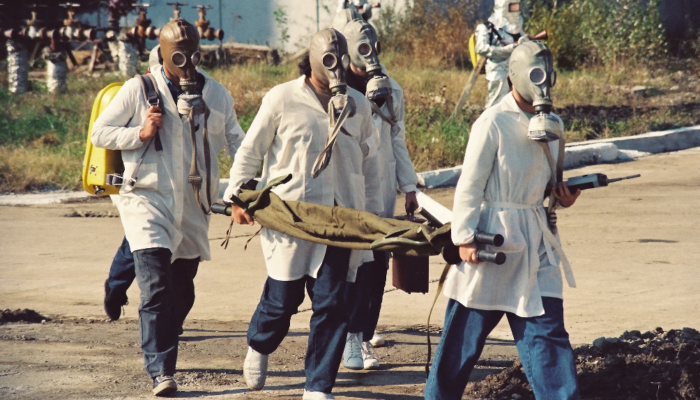
Natural hazards that impact industrial sites and result in technological accidents, causing the release of hazardous substances, are referred to as Natech events. In the popular imagination, Natech accidents are triggered by major natural hazard events. However, experience tells us that low magnitude natural events, such as lightning or heavy rains, are sufficient to cause enormous adverse effects. Today, I have the pleasure to chat with Eng. Alessio Misuri, who will shed some light on the collision between the natural and technological worlds, the so-called Natech.
 A couple of words about our special guest: Alessio Misuri is a PhD candidate at the University of Bologna, at the Department of Civil, Chemical, Environmental, and Materials Engineering. He explores the complexities of Natech events, cascading scenarios led by the interaction of natural hazards and technological infrastructures handling hazardous substances and developing comprehensive methodologies for assessing the related risks. He was a visiting PhD candidate at the Disaster Prevention Research Institute (DPRI) of Kyoto University in 2019. He conducted field surveys in areas impacted by severe Natech accidents, like the Fukushima Dai-Ichi nuclear power station affected by the 2011 Tohoku earthquake and tsunami.
A couple of words about our special guest: Alessio Misuri is a PhD candidate at the University of Bologna, at the Department of Civil, Chemical, Environmental, and Materials Engineering. He explores the complexities of Natech events, cascading scenarios led by the interaction of natural hazards and technological infrastructures handling hazardous substances and developing comprehensive methodologies for assessing the related risks. He was a visiting PhD candidate at the Disaster Prevention Research Institute (DPRI) of Kyoto University in 2019. He conducted field surveys in areas impacted by severe Natech accidents, like the Fukushima Dai-Ichi nuclear power station affected by the 2011 Tohoku earthquake and tsunami.
-
Alessio, in the introduction, I have defined in a few words the word Natech. But can you tell us more about those accidents and the most common adverse effects? Is there any helpful categorisation to define them?
The word “Natech” appeared for the first time in literature in the Eighties. These early studies investigated the releases of hazardous substances from industrial sites after natural hazards’ occurrence in the United States. It was coined as a contracted form for “Natural-hazard triggered Technological accident”. Natech applies to all fires, explosions, toxic dispersions, and environmental contamination scenarios, which are the consequence of the interaction between natural events and infrastructures handling hazardous substances (for example, chemical and process plants, power plants, pipelines and substance transportation networks) [1]. One of the key features of Natech events compared to other industrial accidents is that some categories of natural events have a broad impact, leading to simultaneous scenarios arising from multiple damaged items. For instance, the 1999 Kocaeli earthquake caused several Natech events that involved the refineries and process sites of one of the most industrialised regions of Turkey, exacerbating the already catastrophic destruction brought by the intense seismic load.
In addition, natural hazards might affect the sites at the systemic level. Besides the damages to the main equipment storing hazardous substances, auxiliary systems required to guarantee the infrastructure operability (for example, power connection, cooling water) and safety systems implemented to prevent and mitigate harmful scenarios might be impacted (for example, firefighting network, containment dikes). Such a systemic impact is a crucial issue of Natech events. The reduced performance of these systems, on the one hand, can hamper the effectiveness of accident mitigation strategies, enhancing the likelihood of accident propagation, while on the other can also generate unexpected scenarios usually not deemed credible by plant managers. The severe accident involving an Arkema peroxide production site in Crosby (TX) in 2017, and the tremendous Fukushima nuclear disaster of 2011, are two clear examples of this latter dynamic [2].
It should also be noted that contrary to the common belief that Natech events are rare events, “Black Swans”, according to some practitioners, are not. Indeed, not only natural hazards such as earthquakes and floods but also more frequent events such as storms, lightning strikes, and extreme temperatures can result in severe technological damage [3]. According to a recent study based on a comprehensive database review, storms and tropical storms caused most Natech events, with more than 5,700 accidents in the last 70 years [3]. For instance, storms and the related floods caused severe Natech events in recent years in Japan, questioning the safety of manufacturing facilities when exposed to unexpectedly intense rainfall [4]. Also, extreme temperatures and lightning strikes caused a significant share of the records: while these natural events are often overlooked, they led to more than 2,000 accidents in the last 70 years [3]. More importantly, some natural phenomena might experience an increased severity as a direct effect of factors as climate change and urbanisation and industrialization growth. The latters might, in turn, influence the exposure and vulnerability of the industrial sector to natural hazards and lead to an increase in the number of Natech events in case effective strategies are not implemented. An indication that the trend of Natech events might be already growing can be found by looking at the number of accidents per active site per year between 2000 and 2017, as shown in Figure 1 [3].

Trend of the number of Natech events per number of industrial sites in Europe and the United States between 2000 and 2017. Modified from [3].
-
How is the Natech Risk Assessment measured and applied?
There are several approaches to Natech Risk Assessment to date. Given that this category of accidents is classified as “technological events” (despite having specificities going way beyond the sole technological aspects of the issue), several authors naturally attempted to tailor established procedures used in industrial practice to the Natech case.
Nowadays, we have several tools available. We can use simple qualitative methods (for example, see the Rapid Natech Risk Assessment (RNRA) [5]) and semi-quantitative methodologies (for example, the RAPID-N tool developed by the European Commission [6]) suitable for screening purposes. We can also use quantitative approaches based on the Quantitative Risk Assessment (QRA) rationale to evaluate Natech risk metrics [7]. Although several aspects of Natech events are still hard to model, these examples are valuable tools to support decision-making. For instance, an ad-hoc approach was recently conceived to perform the QRA of Natech events considering the possible depletion of safety measures and the related possibility of accident propagation. However, it has not been applied at the industrial level to date [8]. The path toward a comprehensive assessment of Natech risk is steep and bumpy. Still, we should be optimistic since research is particularly active in fostering our understanding of such complex events.
-
I perceive that the analysis of multi-hazard risks is a highly complex task. From data to action, who are the stakeholders implied in the management of Natech risks?
That is correct. Implementing effective Natech risk governance is a challenging objective due to the multi-hazard nature of this type of accident. In several countries, the legal framework for the prevention and mitigation of chemical accidents evolved over the years to address the issue of Natech events. The regulation in force in the European Union is one of the most advanced on the theme. Indeed, the last amendment of the regulation for controlling major-accident hazards, the Seveso III Directive adopted in 2012, mandates industries handling relevant quantities of hazardous chemicals to explicitly consider the possibility that natural hazards cause harmful deviations and major accidents. Nevertheless, this can be considered just a first step toward effective Natech risk management: several specificities of such complex events, as the impacts of natural hazards and Natech scenarios on emergency procedures, or the interdependencies between industrial installations or the role of other relevant stakeholders as lifelines and communities, are generally not assessed yet. Addressing these points through a territorial approach would be pivotal in fostering industry resilience and societal protection from Natech events.
Implementing effective Natech risk governance is a challenging objective due to the multi-hazard nature of this type of accident
-
At the global level, is there any hotspot that is more prone to Natech effects? Or is that hazard-specific rather than site-specific?
It is hard to reply to this question since it depends on several factors like the number of natural disasters impacting an area, the level of industrialization, the industry preparedness, the implemented regulation on accident reporting rules, and the accuracy of entries in available accident databases. Nevertheless, some interesting indications have been obtained comparing the numbers of natural disasters and reported Natech events per country (see Figure 2). It might not be surprising to see North America as a hotspot. Each natural hazard occurrence generates on average 3.5 Natech events [3]. For example, the highly industrialised U.S. states bordering the Gulf of Mexico are affected by Atlantic hurricanes that every year contribute to generating several Natech scenarios involving fixed and offshore facilities. Following North America, the second most impacted area is Europe, with 0.5 Natech events on average per natural hazard occurrence (totalling about 900 Natech events in the last 70 years). In all the other areas, the numbers are lower (everywhere below 70 events in the last 70 years), although this result can be attributed partly to underreporting or to the lower industrialization of some countries [3].

Figure 2: Comparison between the number of natural disasters and the number of Natech accidents per country in the last 70 years. Modified from [3].
References
[1] Krausmann E, Cruz AM, Salzano E. Natech Risk Assessment and Management: Reducing the Risk of Natural-Hazard Impact on Hazardous Installations. Amsterdam, The Netherlands: Elsevier Inc.; 2017.
[2] Misuri A, Cozzani V. A paradigm shift in the assessment of Natech scenarios in chemical and process facilities. Process Saf Environ Prot 2021;152:338–51. https://doi.org/10.1016/j.psep.2021.06.018.
[3] Ricci F, Casson Moreno V, Cozzani V. A comprehensive analysis of the occurrence of Natech events in the process industry. Process Saf Environ Prot 2021;147:703–13. https://doi.org/10.1016/j.psep.2020.12.031.
[4] Misuri A, Cruz AM, Park H, Garnier E, Ohtsu N, Hokugo A, et al. Technological accidents caused by floods: The case of the Saga prefecture oil spill, Japan 2019. Int J Disaster Risk Reduct 2021;66:102634. https://doi.org/10.1016/j.ijdrr.2021.102634.
[5] Cruz AM, Okada N. Methodology for preliminary assessment of Natech risk in urban areas. Nat Hazards 2008;46:199–220. https://doi.org/10.1007/s11069-007-9207-1.
[6] Girgin S, Krausmann E. RAPID-N: Rapid natech risk assessment and mapping framework. J Loss Prev Process Ind 2013;26:949–60. https://doi.org/10.1016/j.jlp.2013.10.004.
[7] Antonioni G, Landucci G, Necci A, Gheorghiu D, Cozzani V. Quantitative assessment of risk due to NaTech scenarios caused by floods. Reliab Eng Syst Saf 2015;142:334–45. https://doi.org/10.1016/j.ress.2015.05.020.
[8] Misuri A, Landucci G, Cozzani V. Assessment of risk modification due to safety barrier performance degradation in Natech events. Reliab Eng Syst Saf 2021;212:107634. https://doi.org/10.1016/j.ress.2021.107634.
Post edited by Valeria Cigala and Joana Parente
